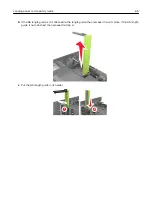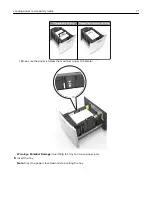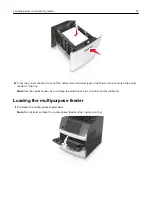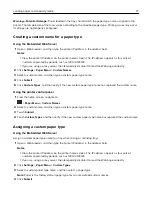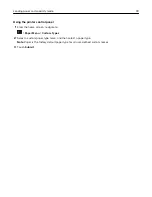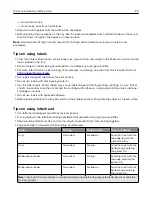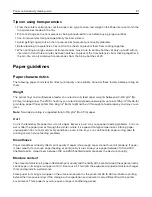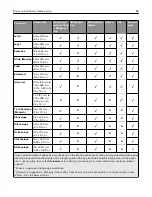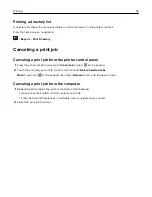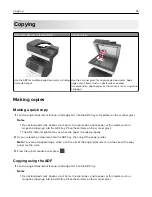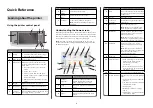
Grain direction
Grain refers to the alignment of the paper fibers in a sheet of paper. Grain is either
grain long
, running the length
of the paper, or
grain short
, running the width of the paper.
For 60–176 g/m
2
(16–47
‑
lb) paper, grain long paper is recommended.
Fiber content
Most high
‑
quality xerographic paper is made from 100% chemically treated pulped wood. This content provides
the paper with a high degree of stability, resulting in fewer paper feeding problems and better print quality.
Paper containing fibers such as cotton can negatively affect paper handling.
Selecting paper
Using the appropriate paper prevents jams and helps ensure trouble
‑
free printing.
To help avoid paper jams and poor print quality:
•
Always
use new, undamaged paper.
•
Before loading paper, know the recommended printable side of the paper. This information is usually
indicated on the paper package.
•
Do not
use paper that has been cut or trimmed by hand.
•
Do not
mix paper sizes, types, or weights in the same tray; mixing results in jams.
•
Do not
use coated papers unless they are specifically designed for electrophotographic printing.
Selecting preprinted forms and letterhead
•
Use grain long for 60–90
‑
g/m
2
(16–24
‑
lb) paper.
•
Use only forms and letterhead printed using an offset lithographic or engraved printing process.
•
Avoid paper with rough or heavily textured surfaces.
•
Use inks that are not affected by the resin in toner. Inks that are oxidation
‑
set or oil
‑
based generally meet
these requirements; latex inks might not.
•
Print samples on preprinted forms and letterheads considered for use before buying large quantities. This
determines whether or not the ink in the preprinted form or letterhead will affect print quality.
•
When in doubt, contact your paper supplier.
Using recycled paper and other office papers
As an environmentally conscientious company, Lexmark supports the use of recycled paper produced
specifically for use in laser (electrophotographic) printers.
While no blanket statement can be made that all recycled paper will feed well, Lexmark consistently tests papers
that represent recycled cut size copier papers available on the global market. This scientific testing is conducted
with rigor and discipline. Many factors are taken into consideration both separately and as a whole, including
the following:
•
Amount of post-consumer waste (Lexmark tests up to 100% post-consumer waste content.)
•
Temperature and humidity conditions (Testing chambers simulate climates from all over the world.)
•
Moisture content (Business papers should have low moisture: 4–5%.)
•
Bending resistance and proper stiffness means optimum feeding through the printer.
Paper and specialty media guide
82


